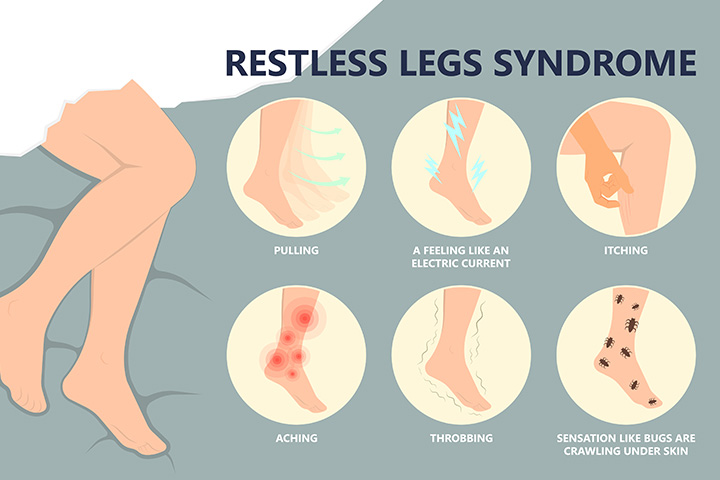
Symptoms of Restless Legs Syndrome
People with restless legs syndrome have uncomfortable sensations in their legs (and sometimes arms or other parts of the body) and an irresistible urge to move their legs to relieve the sensations. The condition causes an uncomfortable, “itchy,” “pins and needles,” or “creepy crawly” feeling in the legs. The sensations are usually worse at rest, especially when lying or sitting.
The severity of RLS symptoms ranges from mild to intolerable. Symptoms can come and go and severity can also vary. The symptoms are generally worse in the evening and at night. For some people, symptoms may cause severe nightly sleep disruption that can significantly impair their quality of life.
Who Gets Restless Legs Syndrome?
Restless legs syndrome may affect up to 10% of the U.S. population. It affects both sexes, but is more common in women and may begin at any age, even in young children. Most people who are affected severely are middle-aged or older.
RLS is often unrecognized or misdiagnosed. This is especially true if the symptoms are intermittent or mild. Once correctly diagnosed, RLS can often be treated successfully.
Causes of Restless Legs Syndrome
In most cases, doctors do not know the cause of restless legs syndrome; however, they suspect that genes play a role. Nearly half of people with RLS also have a family member with the condition.
Other factors associated with the development or worsening of restless legs syndrome include:
- Chronic diseases. Certain chronic diseases and medical conditions, including iron deficiency, Parkinson’s disease, kidney failure,diabetes, and peripheral neuropathy often include symptoms of RLS. Treating these conditions often gives some relief from RLS symptoms.
- Medications. Some types of medications, including antinausea drugs, antipsychotic drugs, some antidepressants, and cold and allergymedications containing sedating antihistamines, may worsen symptoms.
- Pregnancy. Some women experience RLS during pregnancy, especially in the last trimester. Symptoms usually go away within a month after delivery.
Other factors, including alcohol use and sleep deprivation, may trigger symptoms or make them worse. Improving sleep or eliminating alcohol use in these cases may relieve symptoms.
Treatment for Restless Legs Syndrome
Treatment for RLS is targeted at easing symptoms. In people with mild to moderate restless legs syndrome, lifestyle changes, such as beginning a regular exercise program, establishing regular sleep patterns, and eliminating or decreasing the use of caffeine, alcohol, and tobacco, may be helpful. Treatment of an RLS-associated condition also may provide relief of symptoms.
Other non-drug RLS treatments may include:
Leg massages
- Hot baths or heating pads or ice packs applied to the legs
- Good sleep habits
- A vibrating pad called Relaxis
- Medications may be helpful as RLS treatments, but the same drugs are not helpful for everyone. In fact, a drug that relieves symptoms in one person may worsen them in another. In other cases, a drug that works for a while may lose its effectiveness over time.
Drugs Used to treat RLS include:
- Dopaminergic drugs, which act on the neurotransmitter dopamine in the brain. Mirapex, Neupro, and Requip are FDA-approved for treatment of moderate to severe RLS. Others, such as levodopa, may also be prescribed.
- Benzodiazepines, a class of sedative medications, may be used to help with sleep, but they can cause daytime drowsiness.
- Narcotic pain relievers may be used for severe pain.
- Anticonvulsants, or antiseizure drugs, such as Tegretol, Lyrica, Neurontin, and Horizant.
- Although there is no cure for restless legs syndrome, current treatments can help control the condition, decrease symptoms, and improve sleep.
Gabapentin and Restless Legs Syndrome
Gabapentin is an anticonvulsant medication that is also used to treat Restless Legs Syndrome (RLS). Here’s how it helps:
How Gabapentin Works for RLS:
- Calming Neural Activity: Gabapentin mimics the neurotransmitter GABA (gamma-aminobutyric acid), which helps slow down neural activity in the brain. This calming effect can alleviate the uncomfortable sensations associated with RLS.
- Pain Modulation: By altering the way the body processes pain, gabapentin can reduce the discomfort that comes with RLS.
Effectiveness:
Studies and clinical experience have shown that gabapentin can be effective in reducing the frequency and severity of RLS symptoms. It is particularly useful for patients who do not respond well to other treatments.
Considerations:
- Side Effects: Potential side effects of gabapentin include dizziness, drowsiness, fatigue, peripheral edema, and weight gain. These should be monitored by a healthcare provider.
- Dosage: The dosage of gabapentin for RLS is usually tailored to the individual’s needs and response to the medication. Regular follow-ups are important to adjust the dosage as needed.
Summary:
Gabapentin can be an effective treatment for Restless Legs Syndrome by calming neural activity and altering pain processing. If you are prescribed gabapentin for RLS, it’s important to follow your healthcare provider’s instructions and report any side effects you experience.
